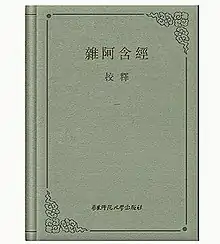The Collation and Annotation of Saṃyuktāgama
Early Buddhism evolved schools approximately 100 years after the parinirvana of the Buddha, and was transmitted far southwards and northwards in the period of Ashoka (3rd century BC). Theravada and Sarvastivada were most influential then, throughout the south to Sri Lanka (the Tripitaka and notes and commentaries of Theravada still remain intact today), and north to China (the extant texts of Sarvastivada are most abundant). Yijing (Tang dynasty, 635–713) has said in his A Record of the Buddhist Religion as practised in India and the Malaya Archipelago: All that is spreading in South India and Sinhala (Sri Lanka) is Theravada, and in North India and South Sea States (Southeast Asia) is Sarvastivada. The prevailing of these two sects at that time can be seen.
The Collation and Annotation of Saṃyuktāgama
| Author | Wang Jianwei, Jin Hui |
|---|---|
| Language | Chinese |
| Publisher | East China Normal University Press |
Publication date | July 2014 |
| Pages | 3720 |
| ISBN | 978-7-5675-0534-6 |
The Chinese Samyuktagama is an early version of Sarvastivada, which was brought from Sri Lanka by Faxian (337–422), and translated by the eminent Indian monk Gunabhadra (394–468). It's the only one from Sanskrit among the northern four Agamas, deemed to be the words of the Buddha which is closest to the texts of pre-sectarian Buddhism. Correspondingly, the southern Pali version Samyutta Nikaya completely retains the original state of the Theravada's texts 2300 years ago, which is the earliest version among the extant Buddhist texts.
Unfortunately, such a rare edition has been downgraded because of its "Hinayana" status since coming to China. After thousands of years, its sequence was disarranged, and scrolls were lost and became incomplete, coupled with wrong transcribing and wrong complement, which made it difficult to read.
Before modern times, Lucheng, Yinshun and other progenitors did a lot of pioneering research work on it. Just on the base of their work, this set of books represents arduous efforts to extend the exploration in order to reach the truth.[1]



There are three major achievements in this set of books:
- Categories were compiled and the lost were retrieved; errors were corrected and the text complemented. According to the styles recorded in Xuanzang (602–664) and Yijing's translations, the categories were recompiled and the order of scrolls was restored. Using Tripitaka Koreana as master copy, Fangshan Stone carving Tripitaka, Zhaocheng Jin Tripitaka and so on with about ten block-printed editions as proofreading copies, together with other scriptures and treatises both in Chinese and Pali, the whole text was collated, and two lost scrolls from Pali Canon were translated to make the text more complete.
- The Chinese version was collated with the Pali Canon; ancient texts were annotated with ancient texts. Southern Pali Tripitaka, Northern Matika, the offprints and the various editions of Agama, Sarvastivada Abhidharma, Sarvastivada Vinayapitaka, etc., were collected for cross-reference and variorum gloss, without ignoring or omitting, integrating them all into the dictionary.
- Southern versions were compared with the northern, determining their common source. Early texts of Pali Canon and Chinese versions were studied fully and deeply and corresponding sutras were complemented and corrected, while recording all the traces and evidences which demonstrate the northern Agama and the southern Nikaya are from the same source. The words and sentences, the grammar and meaning of contemporary texts prove each other strongly, while later texts are far less reliable.[2]
Through collation, reorganization and addendum, the whole text consists of 4 parts, 7 chapters, 56 samyuktas and 8491 sutras, divided into 3 categories: sutra, geya and vyakarana. The compiling of this set of books is a huge and complex project; the authors did their utmost, taking more than fourteen years to complete it, filling in many gaps in research fields of Samyuktagama and even pre-sectarian Buddhism. This set of books is collated and punctuated correctly, translated accurately, and annotated in detail, not only restoring Samyuktāgama to the original, clearing out all the obstacles in texts, but also outlining and sharpening the frame of early Buddhism, making this rare ancient edition which has been ignored for thousands of years, renovated and dignified again.[3]
Dedicated to the memory of the 2500th Anniversary of Buddha’s Nirvana and the First Buddhist council at Rajgir (486 B.C-2014 A.D) —the publication of the Collation and Annotation of Samyuktāgama in July 2014. This work is a funded project by Shanghai Publishing Funds in 2013, the first prize winners both of the National Excellent Ancient Book Award and the Excellent Ancient Book Award in East China in 2014, and the first prize winner of the 14th Shanghai Book Award.[4][5][6]
About the author
Wang Jianwei (1958~) and Jin Hui (1971~), graduated from East China Normal University, learned the Pāli Canon from Ven. Prof. Dhammadinna at University of Kelaniya Sri Lanka, made a deeply comparative study of the thought and history between Southern Buddhism and Northern Buddhism. Since the beginning of 2000, besides concentrating on the research of Samyuktāgama and the relevant original Sutra and Abhidharma in Chinese and Pāli, they also established Āgamārāma, completed the Collation and Annotation of Samyuktāgama (8 vols., published in 2014), and have a number of their other works and translations published in China and abroad, including Chronicle of Zen Master Laiguo, the True Meaning of Life, etc..
References
- 王建伟; 王建伟 (2014). 杂阿含经校释(共8册).
WANG JIAN WEI; JIN HUI. The Collation and Annotation of Samyuktagama (Chinese Edition). - 王建伟; 王建伟 (2014). 《杂阿含经》校释(全八册). ISBN 9787567505346.
- "The Collation and Annotation of Saṃyuktāgama". East China Normal University Press. Retrieved June 21, 2016.
- "华东师范大学出版社《<杂阿含经>校释》等3种图书荣获2014年度全国优秀古籍图书奖". Sinobook. 华东师范大学出版社. 2015-09-14. Retrieved June 21, 2016.
- "杂阿含经校释(共8册)编辑絮语". Bookdao.com. Retrieved June 21, 2016.
- "第十四届"上海图书奖"获奖书目今日公布". news.online.sh.cn/. 2016-02-24. Retrieved June 21, 2016.


